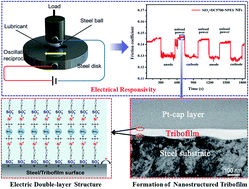High lubricity and electrical responsiveness of solvent-free ionic SiO2 nanofluids†
Abstract
Solvent-free ionic nanofluids with a core–shell structure were successively synthesized via functionalizing silica nanoparticles with a charged corona and ionically tethering with oligomeric chains as a canopy. It was demonstrated that the as-synthesized nanofluids were endowed with outstanding dispersion stability and fluidity. Importantly, when used as a lubricant and additive, the nanofluids showed excellent friction-reducing and antiwear properties. That is, blending even a small fraction of nanofluids into polyethylene glycol base oil dramatically reduced the friction and wear of a steel–steel contact. Depending on the specific shell structures, the lubricity of the nanofluids exhibited a responsive characteristic to electrical potential. The friction coefficients can be adjusted by loading or unloading the external power and changing the direction of the electrical potential. Formation of a unique double electric layer consisting of both organic and inorganic materials during the friction was proposed, which can be essential for yielding robust lubrication of the adsorption film. Moreover, a nanostructured tribofilm comprising a significant fraction of silica and tribo-chemical products of the organic layers was identified, and it was believed to be significant in improving the boundary lubrication performance.



 Please wait while we load your content...
Please wait while we load your content...